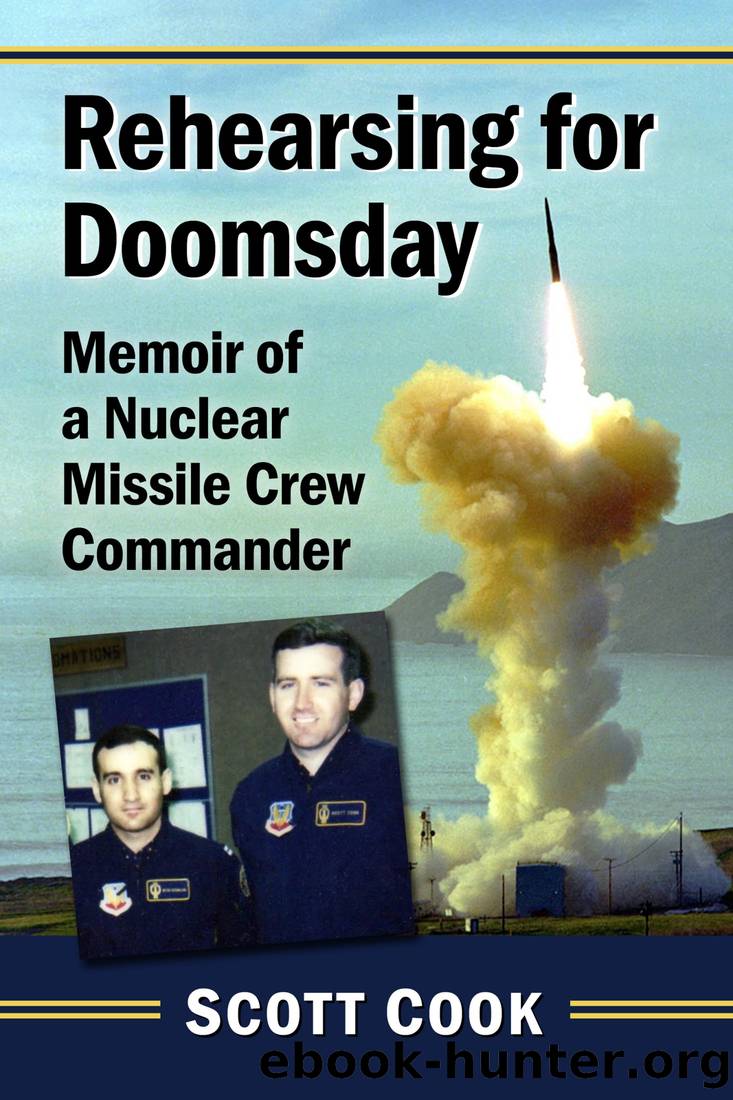Rehearsing for Doomsday by Scott Cook

Author:Scott Cook [Cook, Scott]
Language: eng
Format: epub
ISBN: 9781476686370
Publisher: McFarland
Published: 2021-10-20T00:00:00+00:00
Oscar-Zero control center viewed from the entrance, looking forward towards the status console. A small bathroom (no shower) and refrigerator are off camera, to the immediate right and left, respectively (Library of Congress, HAER ND-12-B-7).
Chapter 16
The Missileer Code
Diversity was not the strength of the 321st Strategic Missile Wingâs crew force. Approximately 90 percent of their numbers were male, most between 23 and 33 years of age, politically conservative and from Âlower-middle class to middle class backgrounds. They were also overwhelmingly Caucasian, although interestingly enough, my first two squadron commanders were Black. However, there was a small but vocal number of Âself-professed liberals sprinkled within the crews. The same could not be said for any gay missileers. I assume there were some. However, during my four years at Grand Forks, I never heard a single rumor about any officer being homosexual. Of course, admitting you were a homosexual in 1990 was grounds for dismissal from the service.
One important characteristic all 200 officers shared was competition for rank and recognition. Yet, as in any career where hard data is lacking, missileer reputations were built primarily on the twin pillars of personality and perception.
Facts are hard to come by in a missile wing where work is primarily accomplished behind secured doors, in windowless trainers or hidden below a North Dakota wheat field. Therefore, most of us had little direct knowledge of each otherâs job performance. As a deputy, the only crew members you observed on duty were the dozen or so commanders with whom you were assigned to pull alert.
Since most alerts were fairly uneventful, the best opportunity to observe a crew partnerâs performance under pressure was in the trainer. That interaction was even more exclusive, including no more than five or six people. A lieutenant had even less opportunities to observe his or her fellow deputies. Deputies were never paired with each other on alert or in the trainer.
So, most crew membersâ opinions of their peers were based on either random personal interactions or unreliable Âsecond-hand information. This situation tended to favor those who were socially adept and wore confidence as smartly as a Âwell-pressed uniform. The culture was not as kind to those who, although often Âhard-working and bright, were the social equivalent of a wrinkled suit. As in many areas of life, style covered a multitude of deficiencies while the lack thereof tended to magnify them.
Once a crew member was subjectively assigned a place in the missileer hierarchy, it was hard to move up or down. A few early flubs and you were labeled ânot very sharp.â A few early successes paired with a winning personality and you were âgoing places in the Air Force.â And per human nature, once people make a public assessment, they are loath to change it. Subsequent success by a bottom feeder is attributed to luck or a crew partner who âpulled them through that stellar evaluation.â A golden boyâs stumbles are attributed to bad luck or an incompetent crew partner who he could only save so many times in the trainer.
Download
This site does not store any files on its server. We only index and link to content provided by other sites. Please contact the content providers to delete copyright contents if any and email us, we'll remove relevant links or contents immediately.
Madame Figaro by 27 Janvier 2023(585)
Wondrous Transformations by Alison Li(521)
William Tryon and the Course of Empire by Paul David Nelson(382)
If Wishes Were Coffee by Moore Michelle(340)
Against All Odds by Alex Kershaw(335)
Growing Up Underground by Steven Heller(334)
Jacob H. Schiff by Naomi W. Cohen(308)
Tabloid Love by Bridget Harrison(300)
From Loyalists to Loyal Citizens by Valerie H. McKito(280)
The Missionary of Wall Street: From Managing Money to Saving Souls on the Streets of New York by Stephen F. Auth(278)
Working on the Dock of the Bay by Michael D. Thompson(271)
Beware of Limbo Dancers by Reed Roy;(267)
Against All Odds: A True Story of Ultimate Courage and Survival in World War II by Kershaw Alex(266)
Bronx by Jerome Charyn(263)
Nephew by M.K. Asante(261)
Growing Up with Clemente by Peterson Richard;(259)
Crossing Highbridge by Waters Maureen;(259)
Pioneer Mother by Hillary Brown(255)
Studying Wisconsin by Martha Bergland & Paul G. Hayes(252)
